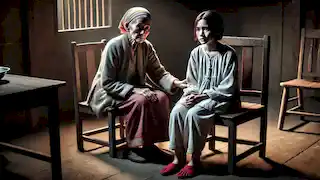Once upon a time, in a quaint village nestled along the Danish coast, there lived a young girl named Karen. She was an orphan, taken in by a kindly old lady who had few means but a generous heart. The old lady, though not wealthy, provided Karen with all she could—a warm home, simple meals, and an abundance of love. Karen, with her bright eyes and infectious smile, was the joy of her foster mother's life. Despite their modest living, Karen possessed a charm that endeared her to everyone she met.
As Karen grew, her natural beauty and grace became more apparent. She loved dancing, and it was not uncommon to see her twirling through the village, her bare feet barely touching the ground. The villagers would often stop to watch, captivated by her lightness and the joy that seemed to radiate from her every move. Karen dreamed of one day becoming a dancer, though she knew it was a distant hope, given her circumstances.
One winter's day, everything changed when Karen received a pair of beautiful red shoes as a gift. They were given to her by a local shoemaker, known for his craftsmanship and occasional eccentricity. The shoemaker had noticed Karen's fondness for dancing and, moved by her spirit, decided to create something special for her. The shoes were made of the finest leather, dyed a brilliant shade of red, and adorned with delicate lace. It was said that the shoemaker had woven magic into the shoes, but such tales were often dismissed as mere village folklore.
When Karen first laid eyes on the red shoes, she was mesmerized. They were unlike anything she had ever seen—vibrant and enchanting. As she slipped them on, she felt an inexplicable joy surge through her. The shoes fit perfectly, almost as if they were made for her. She twirled around, admiring how the shoes seemed to dance with her. The old lady, however, warned her to wear them sparingly and only on special occasions, as they were too fine for everyday wear. But Karen couldn't resist the allure of the red shoes; she wore them whenever she could, basking in the attention they brought her.
The villagers were divided in their opinions of Karen's new shoes. Some admired their beauty and praised Karen for her luck, while others whispered that such extravagant footwear was unbecoming for a girl of her station. Nevertheless, Karen loved the shoes, feeling they gave her a sense of confidence and sophistication she had never known before. She wore them to church, to the market, and even when she danced in the village square. The shoes seemed to have a life of their own, responding to Karen's every move with an uncanny grace.
One Sunday, Karen wore the red shoes to church, much to the disapproval of the congregation. The parishioners frowned upon her choice, deeming it inappropriate for the solemnity of the service. Yet, Karen was oblivious, lost in the joy of wearing her prized possession. As the service progressed, something strange happened. The shoes seemed to have a life of their own, tapping and moving even when Karen stood still. It was as if the shoes had taken control of her feet, compelling her to dance.
The priest noticed Karen's restless feet and reprimanded her for her lack of decorum. Embarrassed, Karen tried to stop, but the shoes wouldn't listen. They dragged her out of the church, across the village, and into the forest. No matter how hard she tried, Karen couldn't control them. The villagers were bewildered, whispering about the enchanted shoes and their dangerous allure. Some believed the shoes were cursed, a punishment for vanity and pride. Others thought it was a test of Karen's character.

Karen's life soon became a relentless dance. The shoes would not come off, and she was forced to dance day and night. She danced through fields, over streams, and even into other villages. The once bright and joyful Karen became gaunt and exhausted, her face etched with desperation. She could not eat, sleep, or rest; the shoes demanded constant movement. Her feet bled, and she was plagued by exhaustion, but the shoes would not stop. The villagers, once charmed by her grace, now looked at her with pity and fear.
As Karen danced, she encountered various people. Some tried to help her, offering to cut the shoes off, but to no avail. The shoes seemed to have a will of their own, rejecting any attempts to remove them. Karen danced past wealthy merchants, beggars, and even royalty. Each time, the people she encountered offered different advice—some told her to embrace the shoes' power, while others urged her to find a way to free herself from their curse.
Desperate for help, Karen sought out an old woman who lived at the edge of the village. This woman was rumored to have knowledge of dark magic and curses. Karen begged her to remove the shoes, willing to give up anything for freedom. The old woman listened and, with a heavy heart, told Karen that the only way to be rid of the shoes was to cut off her feet. Horrified, Karen hesitated but, driven by despair, finally agreed.
The old woman prepared a small hut for the grim procedure. She sharpened a gleaming axe, murmuring words of an old incantation. Karen, trembling with fear and anticipation, placed her feet on a wooden block. As the axe came down, Karen felt a sharp pain, and the red shoes, still dancing, disappeared into the forest. Karen was left to find her way back, now crippled and broken. The villagers, upon hearing of her ordeal, were both sympathetic and chastened, recognizing the dangers of vanity and pride. They helped Karen, giving her a pair of wooden feet and a crutch.

Karen's life took a humble turn after that. She moved to a small cottage near the church, dedicating her days to repentance and charity. She became a symbol of humility and penance, often seen praying at the church or helping the needy. The old lady who had taken her in passed away, leaving Karen with a small inheritance. She used it to help the poor and needy, finding solace in her good deeds. She spent her days teaching children and tending to the sick, her once beautiful face now serene and wise.
Despite her physical limitations, Karen's spirit remained unbroken. She became known for her kindness and generosity, and the villagers came to admire her resilience. The church, once a place of judgment, became a sanctuary for Karen. She would often sit in the pews, praying for forgiveness and reflecting on her past. The priest, who had once reprimanded her, now saw her as a beacon of hope and redemption. He often spoke of her in his sermons, using her story as a lesson in humility and grace.
The tale of Karen and the red shoes became a cautionary tale in the village, warning against vanity and excess. It was said that the shoes still danced somewhere deep in the forest, a reminder of the consequences of putting appearance above all else. Karen, however, found peace in her simple life, grateful for the lessons learned and the kindness of those who helped her. She took great care of the children who came to her for stories and advice, teaching them the values of kindness, humility, and inner beauty.
Years passed, and Karen's health deteriorated. She became frail and bedridden, but her spirit remained strong. On her deathbed, she prayed for forgiveness and for her soul to find peace. As she took her last breath, a serene smile crossed her face, and the church bells tolled gently, as if heralding her ascent to heaven. The villagers mourned her passing, remembering her transformation from a vain girl to a humble and kind woman. They buried her beside the old lady who had cared for her, marking her grave with a simple stone.
The red shoes, though never found again, were said to have ceased their dancing, finally at rest. The villagers continued to tell the story of Karen, not as a cautionary tale, but as a story of redemption and the power of humility. They remembered her for her strength, her kindness, and the lessons she imparted. The church became a place of reflection, where people would come to remember Karen and the life she led.

The story of the red shoes lived on, passed down through generations. It was no longer just about the dangers of vanity but also a testament to the power of redemption and the beauty of a humble heart. The village, nestled by the coast, continued to thrive, its people carrying the lessons of Karen's life in their hearts, ensuring that the tale of the red shoes would never be forgotten. Karen's legacy of kindness and humility inspired many, and the village remembered her not for the red shoes, but for the woman she became.
Karen's story reached far beyond the village. Travelers who visited would hear the tale and take it with them, spreading it to other towns and cities. It became a part of the folklore, a story told by grandparents to their grandchildren. Some versions spoke of the red shoes as a caution against vanity, while others focused on Karen's transformation and redemption. Each retelling added its own flavor, but the core message remained the same: true beauty comes from within, and redemption is always possible.
As time went on, the village changed. New generations grew up hearing Karen's story, and the village church became a place of pilgrimage for those seeking solace and inspiration. A small chapel was built near Karen's grave, where people would come to pray and leave offerings. The old lady's cottage, once a humble abode, became a place of historical significance, preserved by the villagers as a reminder of Karen's journey.

The village thrived, and the tale of the red shoes remained a cherished part of its history. Karen's legacy lived on through the generations, a beacon of hope and
a reminder of the power of kindness and humility. The red shoes, now a symbol of both vanity and redemption, became a part of local legend, reminding everyone that true beauty lies not in what we wear but in how we live our lives.
And so, the story of the red shoes ended, not with a dance, but with a quiet, peaceful rest, teaching all who heard it the value of humility and the dangers of vanity. The village, nestled by the coast, continued to thrive, its people carrying the lessons of Karen's life in their hearts, ensuring that the tale of the red shoes would never be forgotten.


















